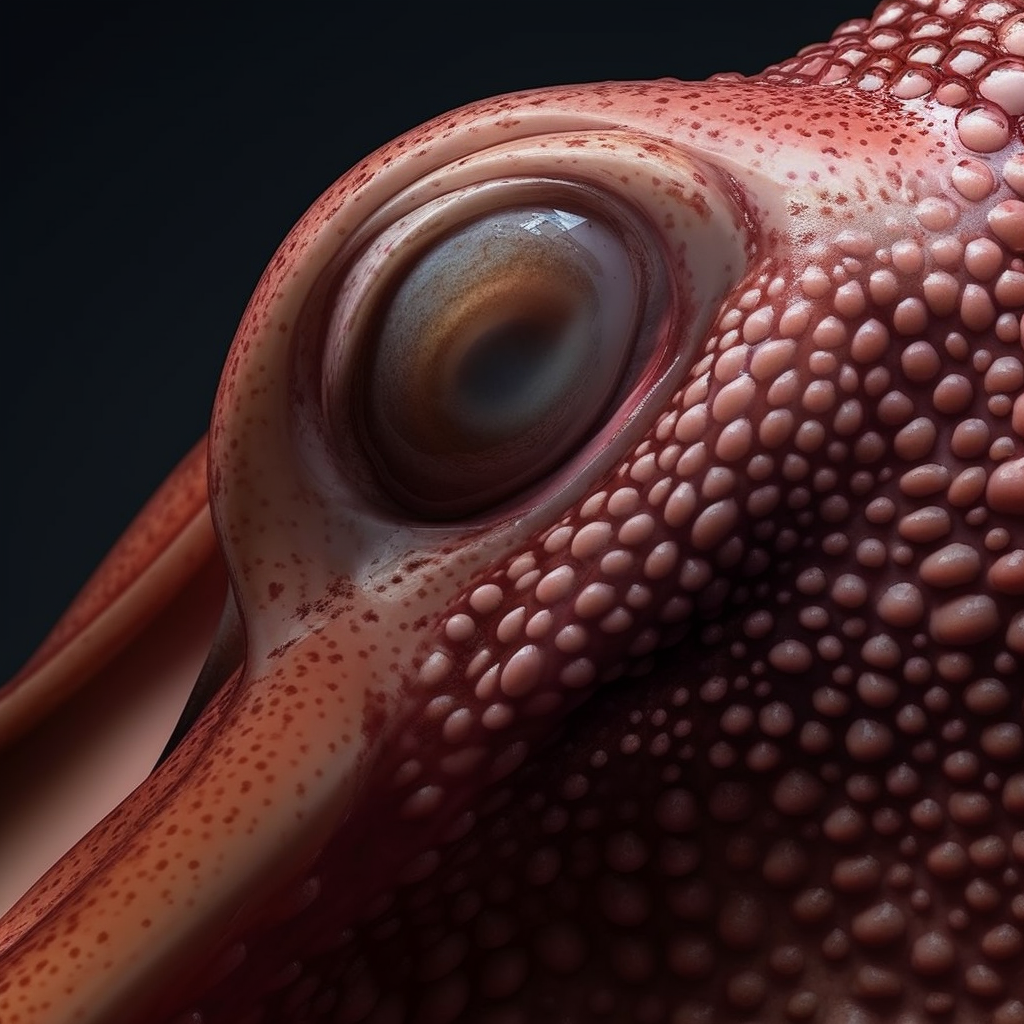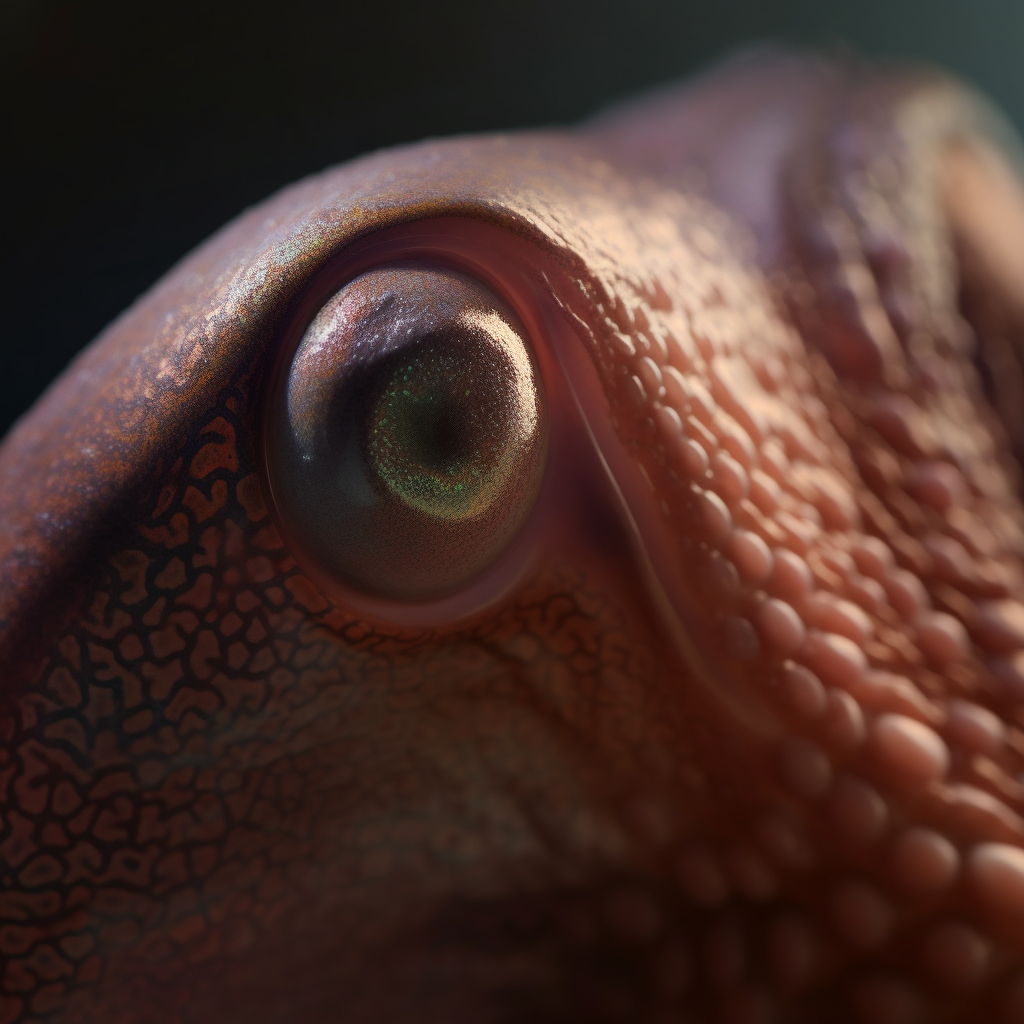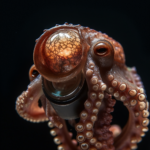The octopus beak is a fascinating and unique feature of these intelligent and highly adaptable creatures. Serving as their primary tool for capturing and consuming prey, the beak is a hard, sharp structure that allows octopuses to break through the tough shells of their prey. This article will explore the anatomy and function of the octopus beak, as well as its importance in the survival and feeding habits of these remarkable cephalopods. So, let’s dive into the world of the octopus beak and discover the wonders it holds.
Key Takeaways
- The octopus beak is a hard, sharp structure located at the center of its arms.
- It is used for capturing and dismembering prey.
- The beak is made of chitin, a tough and flexible material.
- Octopuses can regenerate their beaks if they become damaged.
- The beak is an important adaptation that allows octopuses to survive and thrive in their marine environments.
The Uniqueness of the Octopus Beak
A. What is an Octopus Beak?
When we think of beaks, birds usually come to mind. However, did you know that octopuses also have beaks? Yes, these fascinating creatures possess a unique adaptation known as the octopus beak. The octopus beak is a hard, sharp structure located at the center of the octopus’s mouth. It serves as a powerful tool for capturing and consuming prey.
B. Octopus Beak Anatomy: A Closer Look
To understand the uniqueness of the octopus beak, let’s take a closer look at its anatomy. The octopus beak is made of chitin, a tough and flexible material found in the exoskeletons of arthropods. This beak is composed of two parts, known as the upper and lower mandibles, which come together to form a powerful cutting and crushing mechanism.
The shape and size of the octopus beak can vary depending on the species. Some octopuses have beaks that resemble parrot beaks, while others have beaks that are more elongated and pointed. This diversity in beak morphology allows different octopus species to adapt to their specific prey and habitats.
C. Octopus Beak vs Bird Beak: A Comparative Analysis
Now, let’s compare the octopus beak to the beak of a bird. While both beaks serve the purpose of capturing and consuming food, there are some key differences between them.
-
Material: The octopus beak is made of chitin, a hard and durable substance, whereas bird beaks are made of keratin, the same material found in our hair and nails.
-
Function: Bird beaks are specialized for various tasks such as cracking seeds, probing for insects, or catching fish. On the other hand, the octopus beak is primarily used for capturing and dismembering prey.
-
Mobility: Bird beaks are attached to the bird’s skull and are immobile, while the octopus beak is part of the octopus’s mouth and can move independently.
-
Adaptability: Bird beaks are highly specialized and adapted to the specific diet and feeding habits of each bird species. In contrast, the octopus beak is more versatile and can handle a wide range of prey, including crustaceans, mollusks, and even small fish.
In conclusion, the octopus beak is a remarkable adaptation that sets these intelligent cephalopods apart from other creatures. Its unique anatomy and versatility make it a powerful tool for capturing and consuming prey. So, the next time you marvel at the beak of a bird, remember that the octopus beak is equally fascinating in its own right.
The Intricacies of the Octopus Beak

A. Location of the Octopus Beak: Where is it Found?
The octopus beak is a fascinating structure that plays a crucial role in the life of these intelligent cephalopods. Located at the center of the octopus’s complex anatomy, the beak is situated in the mouth region. It serves as the primary tool for capturing and consuming prey.
When an octopus catches its prey, it uses its powerful arms to bring it towards its beak. The beak acts as a central hub for the octopus’s feeding process, allowing it to efficiently break down and consume its meal. This remarkable adaptation is essential for the octopus’s survival in its marine environment.
B. The Size Factor: How Big is an Octopus Beak?
Octopus beaks come in a variety of sizes, depending on the species and the individual’s age. Generally, the beak size corresponds to the overall size of the octopus. Larger species, such as the Giant Pacific Octopus, have larger beaks, while smaller species have proportionally smaller beaks.
To give you an idea of their size, an average adult octopus beak is typically around the size of a thumbnail. However, some larger species can have beaks that are several centimeters in length. Despite their small size, these beaks are incredibly strong and capable of exerting significant force.
C. The Hardness Quotient: How Hard is an Octopus Beak?
The octopus beak is renowned for its impressive hardness. It is composed of a tough, chitinous material that allows it to withstand the forces exerted during feeding. In fact, the beak is one of the hardest structures found in the animal kingdom.
Scientists have compared the hardness of the octopus beak to that of a human fingernail or a parrot’s beak. This remarkable hardness enables the octopus to break through the shells of its prey, such as crabs and mollusks, which would be challenging for many other predators.
D. The Material Composition: What is Octopus Beak Made of?
The octopus beak is primarily made up of a protein called chitin, which is also found in the exoskeletons of insects and the shells of crustaceans. Chitin is a strong and flexible material that provides the beak with its remarkable properties.
In addition to chitin, the beak also contains a small amount of minerals, such as calcium carbonate, which further enhances its strength. This unique combination of organic and inorganic materials gives the octopus beak its incredible durability and resilience.
To summarize, the octopus beak is a remarkable structure that showcases the incredible adaptations of these intelligent creatures. Its location in the mouth region, its size, hardness, and material composition all contribute to the octopus’s ability to capture and consume its prey effectively. Understanding the intricacies of the octopus beak provides us with valuable insights into the fascinating world of these underwater marvels.
The Functionality of the Octopus Beak
The octopus is a fascinating creature known for its unique anatomy and impressive hunting abilities. One of the most intriguing features of the octopus is its beak, a hard and sharp structure that plays a crucial role in its eating habits and survival. In this section, we will explore the functionality of the octopus beak and delve into its role, use, and strength.
A. The Role of the Beak in Octopus Eating Habits
The beak of an octopus is a vital tool that enables it to consume a wide variety of prey. Octopuses are carnivorous creatures, and their beaks serve as a powerful weapon for capturing and devouring their food. Unlike humans, who use their teeth to chew and break down food, octopuses rely on their beaks to tear apart their prey.
Octopuses have a diverse diet that includes fish, crabs, shrimp, and even other octopuses. The beak allows them to break through the tough shells of crustaceans and the thick skin of fish. It acts as a sharp and efficient cutting tool, allowing the octopus to access the soft flesh inside its prey.
B. The Use of the Beak: What Does an Octopus Beak Do?
The octopus beak is located at the center of its arms, acting as the entrance to its mouth. When hunting, the octopus uses its arms to capture its prey and bring it towards its beak. The beak then grasps the prey and tears it apart, allowing the octopus to consume its meal.
The beak is made of a hard and durable material called chitin, which is similar to the substance found in the exoskeletons of insects. This composition gives the beak the strength it needs to break through the shells and tough exteriors of its prey. The beak is also flexible, allowing the octopus to manipulate it with precision.
C. The Strength of the Beak: How Powerful and Sharp is an Octopus Beak?
The octopus beak is incredibly strong and sharp, capable of exerting an impressive amount of force. Studies have shown that the beak of an octopus can exert pressure equivalent to over 200 pounds per square inch (psi). To put this into perspective, that’s more than enough force to break through the shells of crabs and other hard-bodied prey.
The beak’s sharpness is crucial for the octopus to efficiently tear apart its prey. It is comparable to the beaks of other cephalopods, such as squids and cuttlefish. However, the size and shape of the beak can vary among different species of octopuses, depending on their specific hunting and feeding habits.
In conclusion, the octopus beak is a remarkable adaptation that allows these intelligent creatures to thrive in their marine environments. Its role in the octopus’s eating habits, its use as a cutting tool, and its strength and sharpness all contribute to the octopus’s success as a predator. Understanding the functionality of the octopus beak gives us a glimpse into the fascinating world of these underwater species and their remarkable abilities.
The Variations in Octopus Beaks

A. The Largest Octopus Beak: A Record Holder
Octopuses are fascinating creatures with a wide range of adaptations that allow them to thrive in various marine environments. One of the most intriguing aspects of an octopus’s anatomy is its beak. The beak is a hard, sharp structure that serves as the octopus’s primary tool for capturing and consuming prey.
While octopuses come in different shapes and sizes, their beaks also exhibit variations. Among these variations, some octopuses have the distinction of possessing the largest beaks in the cephalopod world. These record-holding beaks are found in the giant Pacific octopus (Enteroctopus dofleini), which can grow to be the size of a small car.
The beak of the giant Pacific octopus is a formidable weapon. It is made of chitin, a hard, proteinaceous material found in the exoskeletons of arthropods. The beak is capable of delivering a powerful bite, allowing the octopus to tear through the shells of its prey, such as crabs and clams. This impressive beak is a testament to the strength and adaptability of these incredible creatures.
B. Do All Octopuses Have a Beak? Exploring Species Differences
While the beak is a defining characteristic of octopuses, not all species possess this feature. Some species, such as the vampire squid, lack a beak altogether. Instead, they have evolved unique adaptations to capture and consume their prey.
The absence of a beak in certain species is due to their different feeding habits. For example, the vampire squid primarily feeds on marine snow, a mixture of organic particles that sink to the ocean floor. Its diet does not require the use of a beak to break through hard shells or capture fast-moving prey.
Other species of octopuses have smaller beaks compared to their larger counterparts. This variation in beak size is influenced by factors such as the size of their prey and the environment in which they live. Smaller beaks are sufficient for capturing and consuming smaller prey, while larger beaks are necessary for tackling larger and more challenging prey.
C. What Does an Octopus Beak Look Like? Visual Characteristics
The octopus beak is a remarkable structure that is both functional and visually intriguing. It is located at the center of the octopus’s arms, where it serves as the entrance to its mouth. The beak is typically dark in color, ranging from black to brown, and has a glossy appearance.
In terms of shape, the beak resembles that of a parrot’s beak, with a curved and pointed structure. This shape allows the octopus to exert force and apply pressure when biting into its prey. The beak is also serrated, which aids in tearing apart the prey‘s flesh and breaking through shells.
The size of an octopus’s beak varies depending on the species. Smaller species have proportionally smaller beaks, while larger species, like the giant Pacific octopus, have larger beaks capable of delivering a more powerful bite. The beak’s size and strength are essential for the octopus to successfully capture and consume its prey.
In conclusion, the variations in octopus beaks are a testament to the incredible diversity and adaptability of these fascinating creatures. Whether it’s the record-holding beak of the giant Pacific octopus or the absence of a beak in certain species, each adaptation serves a specific purpose in the octopus’s quest for survival. Understanding the intricacies of the octopus beak provides valuable insights into the complex world of cephalopods and their remarkable hunting abilities.
The Impact of the Octopus Beak
A. Octopus Beak Bite: The Force and Strength
The octopus beak is a remarkable adaptation that plays a crucial role in the life of these fascinating creatures. Known for their intelligence and agility, octopuses use their beaks as a powerful tool for capturing and consuming their prey.
The force and strength of an octopus beak bite are truly remarkable. The beak is made of a hard, chitinous material that allows it to exert immense pressure. In fact, studies have shown that the beak of some octopus species can generate a force of up to 200 pounds per square inch (psi). To put that into perspective, it’s like having a small car tire resting on your fingertip!
The beak’s strength is essential for the octopus to break through the tough exoskeletons of crustaceans, such as crabs and lobsters, which form a significant part of their diet. With a single bite, an octopus can crush the shells of its prey, allowing it to access the soft flesh inside.
B. Octopus Beak Facts: Unveiling the Mystery
The octopus beak is a fascinating structure that holds many mysteries waiting to be unraveled. Let’s delve into some intriguing facts about this remarkable adaptation.
-
Composition: The octopus beak is made of a hard, proteinaceous material called chitin. This material is similar to what you find in the exoskeletons of insects and crustaceans. It provides the beak with the necessary strength and durability to perform its functions.
-
Location: The beak is located at the center of the octopus’s arms, where the mouth is situated. It acts as a gateway to the digestive system, allowing the octopus to consume its prey.
-
Versatility: The beak is not only used for biting and breaking through shells but also for tearing apart prey into smaller, more manageable pieces. This versatility allows the octopus to consume a wide range of prey, from small fish to larger crustaceans.
-
Regeneration: Like many other parts of an octopus’s body, the beak has the ability to regenerate. If damaged or worn out, the octopus can grow a new beak to replace the old one. This remarkable regenerative ability ensures that the octopus can continue to hunt and feed effectively.
-
Evolutionary Significance: The octopus beak is believed to have evolved from the radula, a specialized feeding organ found in other mollusks like snails. The radula is a ribbon-like structure with rows of tiny teeth used for scraping and tearing food. Over time, the radula in octopuses transformed into a more robust and efficient beak, allowing for a more effective means of capturing and consuming prey.
In conclusion, the octopus beak is a remarkable adaptation that showcases the incredible abilities of these intelligent creatures. Its force and strength enable the octopus to break through the shells of its prey, while its composition and versatility make it a vital tool for survival. The mysteries surrounding the octopus beak continue to fascinate scientists, and further research will undoubtedly unveil even more intriguing facts about this incredible adaptation.
The Human Interaction with Octopus Beaks

A. The Market for Octopus Beaks: Where to Buy and Why
Octopus beaks, the hard, sharp mouthparts of these intelligent cephalopods, have become a curious commodity in the market. While not as widely sought after as other marine products like shells or squid, octopus beaks have found their niche among collectors, researchers, and even artists.
Collectors and Researchers
For collectors, octopus beaks hold a certain allure due to their unique and intriguing nature. These beaks, made of chitin, are the only hard parts of an octopus’s body. They serve as a testament to the incredible adaptability and survival strategies of these creatures. Octopus beaks are often sought after by those who appreciate the beauty and complexity of marine life.
Researchers also find value in studying octopus beaks. These beaks provide valuable insights into the diet, feeding habits, and hunting techniques of octopuses. By examining the size and shape of the beaks, scientists can gain a better understanding of the prey species targeted by different octopus species. This information contributes to our knowledge of marine ecosystems and helps in the conservation efforts of these fascinating creatures.
Artists and Craftspeople
Octopus beaks have also found their way into the hands of artists and craftspeople. Due to their unique shape and texture, they can be incorporated into various artistic creations. Some artisans use octopus beaks to create intricate jewelry pieces, while others incorporate them into sculptures or mixed media artworks. The natural beauty and durability of these beaks make them an interesting and versatile material for creative expression.
B. Octopus Beak Removal: The How and Why
The removal of octopus beaks is a delicate process that requires precision and care. It is usually done for scientific research purposes or in cases where an octopus has died naturally. The beak removal process allows scientists to study the beaks and gain insights into the diet and feeding habits of these fascinating creatures.
How is it Done?
To remove an octopus beak, the body of the octopus is carefully dissected. The beak is located in the mouth region, protected by muscular tissues. By carefully separating the tissues, researchers can access and extract the beak without causing damage. The beak is then cleaned and preserved for further analysis.
Why is it Done?
The removal of octopus beaks serves several important purposes in scientific research. By studying the beaks, scientists can determine the types of prey consumed by different octopus species. This information helps in understanding the ecological role of octopuses and their impact on marine food webs. Additionally, analyzing the beaks can provide insights into the feeding behavior and hunting strategies employed by octopuses.
C. Octopus Beak for Sale: A Curious Commodity
Although not as widely available as other marine products, octopus beaks can be found for sale in certain markets and online platforms. The demand for these beaks comes from a variety of sources, including collectors, researchers, and individuals with an interest in marine biology.
Where to Buy Octopus Beaks?
Octopus beaks can be purchased from specialized online retailers that cater to collectors and researchers. These retailers often source their beaks from reputable suppliers who obtain them through ethical means, such as from natural mortalities or sustainable fishing practices. It is important to ensure that the beaks are obtained legally and responsibly to support conservation efforts and protect marine ecosystems.
Why Buy Octopus Beaks?
For collectors, purchasing an octopus beak allows them to own a unique and intriguing piece of marine life. These beaks can be displayed as a conversation starter or incorporated into personal collections of natural curiosities. Researchers, on the other hand, buy octopus beaks to further their scientific studies and contribute to our understanding of these fascinating creatures.
In conclusion, the market for octopus beaks caters to a diverse range of individuals, from collectors and artists to researchers and scientists. The demand for these beaks stems from their unique nature and the valuable insights they provide into the world of octopuses. Whether used for artistic expression or scientific exploration, octopus beaks continue to captivate and intrigue those who appreciate the wonders of the marine world. Conclusion
In conclusion, the octopus beak is a remarkable adaptation that allows these intelligent creatures to capture and consume their prey. With its sharp and powerful structure, the beak serves as the primary tool for breaking down the tough shells of crustaceans and other prey items. The beak’s composition of chitin and proteins provides it with strength and flexibility, enabling the octopus to exert significant force while maintaining its durability. The beak’s ability to regenerate also ensures that the octopus can continue to hunt and feed efficiently throughout its life. Understanding the octopus beak not only sheds light on the fascinating anatomy of these cephalopods but also highlights their incredible adaptability and survival strategies in the underwater world.
Frequently Asked Questions
What is an octopus beak?
An octopus beak is a hard, sharp structure located in the center of the octopus’s body, surrounded by its arms. It is made of keratin, the same material found in human nails and hair. This beak is used for hunting, feeding, and defense mechanisms.
How hard is an octopus beak?
The hardness of an octopus beak varies between species, but it is generally very hard and sharp, similar to a bird‘s beak. It is made of keratin and is capable of breaking through the shells of prey like crabs and clams.
Where is the octopus beak located?
The octopus beak is located in the center of their body, surrounded by their arms. This strategic location allows the octopus to deliver a powerful bite to its prey or potential threats.
What does an octopus beak do?
The octopus uses its beak for hunting and feeding. It can crack open the shells of mollusks and crustaceans, its primary food sources. The beak is also used in defense against predators.
How strong is an octopus beak?
The strength of an octopus beak can vary depending on the species, but it is generally strong enough to crack open the shells of crustaceans and mollusks. Some larger species of octopus may even have beaks capable of puncturing human skin.
Why do octopuses have beaks?
Octopuses have beaks to help them hunt and eat their prey. The beak is used to break open the shells of crustaceans and mollusks, which are the primary food sources for octopuses. It also serves as a defense mechanism against predators.
What is the largest octopus beak?
The largest octopus beak belongs to the Giant Pacific Octopus, which is the largest species of octopus in the world. The beak of this species can reach up to 2 inches in length.
How to remove an octopus beak?
Removing an octopus beak should only be done by trained professionals, as it can be harmful to the octopus if done incorrectly. The process usually involves carefully separating the beak from the surrounding muscle tissue.
Do all octopuses have a beak?
Yes, all octopuses have a beak. It is a key part of their anatomy, used for hunting, feeding, and defense.
What is the difference between an octopus beak and a bird beak?
While both beaks serve similar functions in terms of feeding, they are quite different. A bird’s beak is external and often plays a role in courtship and communication, while an octopus’s beak is internal, located in the center of its body, and is primarily used for hunting and defense.




